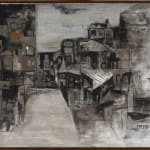Ram Kumar
Benares, Circa 1964
Oil on canvas
68.6 x 77.5 cm
27 1/8 x 30 1/2 in
27 1/8 x 30 1/2 in
Signed in Devanagari lower right, inscribed 'RAM KUMAR/ "BENARES' on the reverse
Further images
'Of his first visit to the holy city of Benares in the winter of 1960, Indian painter Ram Kumar said: “It was the middle of winter. And I had reached...
"Of his first visit to the holy city of Benares in the winter of 1960, Indian painter Ram Kumar said: “It was the middle of winter. And I had reached the city late at night. The dimly lit lanes were deserted and gave an impression of a ghostly deserted city. Except for the occasional howl of stray dogs, all was quiet. I thought the city was inhabited only by the dead and their dead souls. It looked like a haunted place and still remains the same… Every sight was like a new composition, a still life artistically organized to be interpreted in colours. It was not merely outward appearances which were fascinating but they were vibrant with an inner life of their own, very deep and profound, which left an everlasting impression on my artistic sensibility.”
The artist quoted in Ram Kumar: A Journey Within, ed. G. Gil, New Delhi, 1996, p. 89.
“Ram Kumar’s Benares appears like a mirage of a city, a bleak apparition seen in the early hours of dawn or at dusk, just before nightfall, a sort of subliminal city; a grey and brown ensemble of dilapidated forms rather than a site of human habitation. Sometimes the view is clearer: shrines and squalid tenements huddled along the riverfront; their foundations submerged in the muddy water.” G. Kapur, Contemporary Indian Artists, New Delhi, 1978, p. 75
The artist quoted in Ram Kumar: A Journey Within, ed. G. Gil, New Delhi, 1996, p. 89.
“Ram Kumar’s Benares appears like a mirage of a city, a bleak apparition seen in the early hours of dawn or at dusk, just before nightfall, a sort of subliminal city; a grey and brown ensemble of dilapidated forms rather than a site of human habitation. Sometimes the view is clearer: shrines and squalid tenements huddled along the riverfront; their foundations submerged in the muddy water.” G. Kapur, Contemporary Indian Artists, New Delhi, 1978, p. 75
Provenance
Private Collection, Virginia, USA, acquired from Kumar Art Gallery, New Delhi in the early 1970sExhibitions
South Asian Modern Art 2022, Grosvenor Gallery, London, 10 June - 1 July 2022, No. 12, (illustrated in the exhibition catalogue)













